winter tyres OPEL ASTRA SALOON 2014 Owners Manual
[x] Cancel search | Manufacturer: OPEL, Model Year: 2014, Model line: ASTRA SALOON, Model: OPEL ASTRA SALOON 2014Pages: 245, PDF Size: 7.12 MB
Page 190 of 245
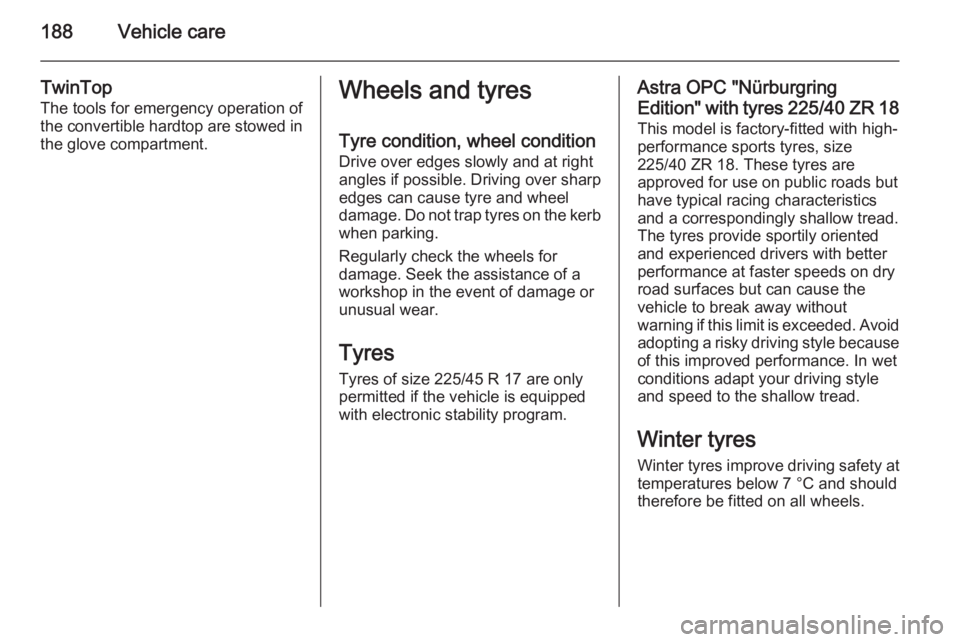
188Vehicle care
TwinTop
The tools for emergency operation of
the convertible hardtop are stowed in
the glove compartment.Wheels and tyres
Tyre condition, wheel condition
Drive over edges slowly and at right
angles if possible. Driving over sharp
edges can cause tyre and wheel
damage. Do not trap tyres on the kerb when parking.
Regularly check the wheels for
damage. Seek the assistance of a
workshop in the event of damage or
unusual wear.
Tyres
Tyres of size 225/45 R 17 are only
permitted if the vehicle is equipped
with electronic stability program.Astra OPC "Nürburgring
Edition" with tyres 225/40 ZR 18
This model is factory-fitted with high-
performance sports tyres, size
225/40 ZR 18. These tyres are
approved for use on public roads but
have typical racing characteristics
and a correspondingly shallow tread.
The tyres provide sportily oriented
and experienced drivers with better
performance at faster speeds on dry
road surfaces but can cause the
vehicle to break away without
warning if this limit is exceeded. Avoid adopting a risky driving style because
of this improved performance. In wet conditions adapt your driving style
and speed to the shallow tread.
Winter tyres Winter tyres improve driving safety at
temperatures below 7 °C and should
therefore be fitted on all wheels.
Page 191 of 245
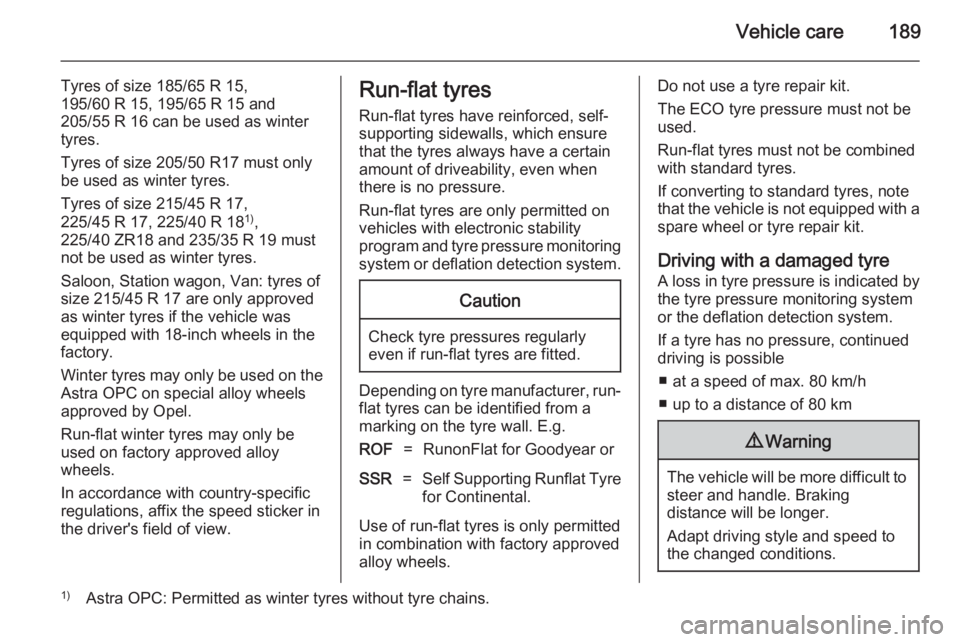
Vehicle care189
Tyres of size 185/65 R 15,
195/60 R 15, 195/65 R 15 and
205/55 R 16 can be used as winter
tyres.
Tyres of size 205/50 R17 must only
be used as winter tyres.
Tyres of size 215/45 R 17,
225/45 R 17, 225/40 R 18 1)
,
225/40 ZR18 and 235/35 R 19 must not be used as winter tyres.
Saloon, Station wagon, Van: tyres of
size 215/45 R 17 are only approved
as winter tyres if the vehicle was equipped with 18-inch wheels in the
factory.
Winter tyres may only be used on the Astra OPC on special alloy wheels
approved by Opel.
Run-flat winter tyres may only be
used on factory approved alloy
wheels.
In accordance with country-specific
regulations, affix the speed sticker in
the driver's field of view.Run-flat tyres
Run-flat tyres have reinforced, self-
supporting sidewalls, which ensure
that the tyres always have a certain
amount of driveability, even when
there is no pressure.
Run-flat tyres are only permitted on
vehicles with electronic stability
program and tyre pressure monitoring system or deflation detection system.Caution
Check tyre pressures regularly
even if run-flat tyres are fitted.
Depending on tyre manufacturer, run-
flat tyres can be identified from a
marking on the tyre wall. E.g.
ROF=RunonFlat for Goodyear orSSR=Self Supporting Runflat Tyre
for Continental.
Use of run-flat tyres is only permitted
in combination with factory approved
alloy wheels.
Do not use a tyre repair kit.
The ECO tyre pressure must not be
used.
Run-flat tyres must not be combined
with standard tyres.
If converting to standard tyres, note
that the vehicle is not equipped with a spare wheel or tyre repair kit.
Driving with a damaged tyre
A loss in tyre pressure is indicated by
the tyre pressure monitoring system
or the deflation detection system.
If a tyre has no pressure, continued
driving is possible
■ at a speed of max. 80 km/h
■ up to a distance of 80 km9 Warning
The vehicle will be more difficult to
steer and handle. Braking
distance will be longer.
Adapt driving style and speed to the changed conditions.
1) Astra OPC: Permitted as winter tyres without tyre chains.
Page 192 of 245
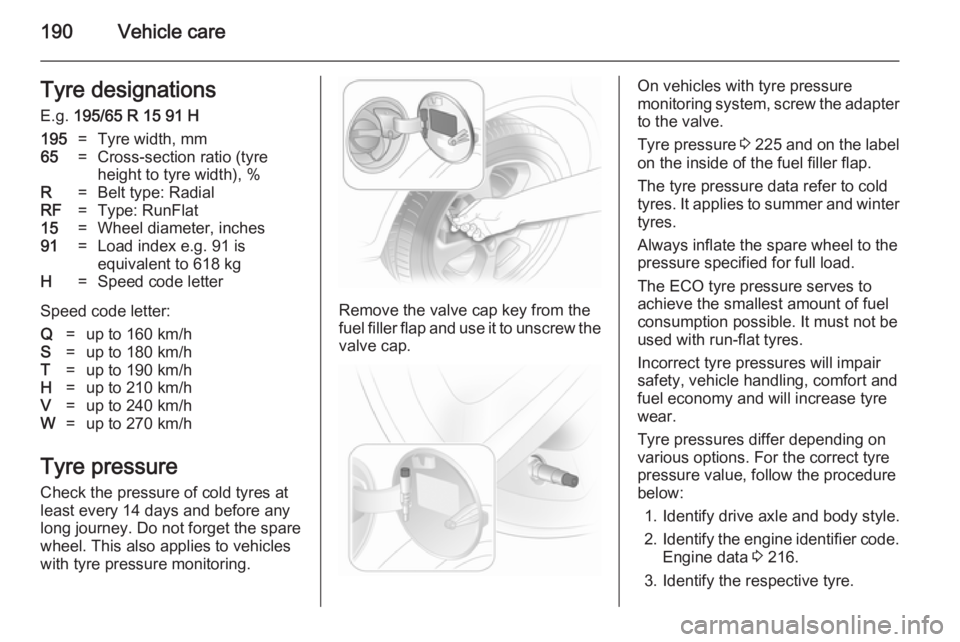
190Vehicle careTyre designationsE.g. 195/65 R 15 91 H195=Tyre width, mm65=Cross-section ratio (tyre
height to tyre width), %R=Belt type: RadialRF=Type: RunFlat15=Wheel diameter, inches91=Load index e.g. 91 is
equivalent to 618 kgH=Speed code letter
Speed code letter:
Q=up to 160 km/hS=up to 180 km/hT=up to 190 km/hH=up to 210 km/hV=up to 240 km/hW=up to 270 km/h
Tyre pressure
Check the pressure of cold tyres at
least every 14 days and before any
long journey. Do not forget the spare
wheel. This also applies to vehicles
with tyre pressure monitoring.
Remove the valve cap key from the
fuel filler flap and use it to unscrew the
valve cap.
On vehicles with tyre pressure
monitoring system, screw the adapter
to the valve.
Tyre pressure 3 225 and on the label
on the inside of the fuel filler flap.
The tyre pressure data refer to cold
tyres. It applies to summer and winter tyres.
Always inflate the spare wheel to the
pressure specified for full load.
The ECO tyre pressure serves to
achieve the smallest amount of fuel
consumption possible. It must not be used with run-flat tyres.
Incorrect tyre pressures will impair
safety, vehicle handling, comfort and
fuel economy and will increase tyre
wear.
Tyre pressures differ depending on
various options. For the correct tyre
pressure value, follow the procedure
below:
1. Identify drive axle and body style.
2. Identify the engine identifier code.
Engine data 3 216.
3. Identify the respective tyre.
Page 193 of 245
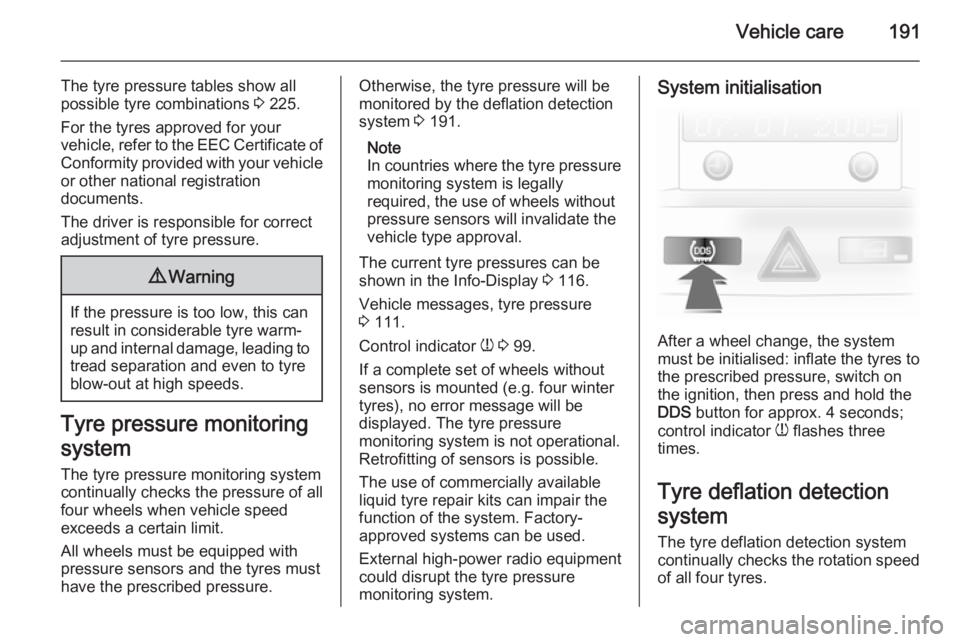
Vehicle care191
The tyre pressure tables show all
possible tyre combinations 3 225.
For the tyres approved for your
vehicle, refer to the EEC Certificate of Conformity provided with your vehicle
or other national registration
documents.
The driver is responsible for correct
adjustment of tyre pressure.9 Warning
If the pressure is too low, this can
result in considerable tyre warm-
up and internal damage, leading to tread separation and even to tyre
blow-out at high speeds.
Tyre pressure monitoring
system
The tyre pressure monitoring system
continually checks the pressure of all
four wheels when vehicle speed
exceeds a certain limit.
All wheels must be equipped with
pressure sensors and the tyres must
have the prescribed pressure.
Otherwise, the tyre pressure will be monitored by the deflation detection
system 3 191.
Note
In countries where the tyre pressure
monitoring system is legally
required, the use of wheels without
pressure sensors will invalidate the
vehicle type approval.
The current tyre pressures can be
shown in the Info-Display 3 116.
Vehicle messages, tyre pressure
3 111.
Control indicator w 3 99.
If a complete set of wheels without
sensors is mounted (e.g. four winter
tyres), no error message will be
displayed. The tyre pressure
monitoring system is not operational.
Retrofitting of sensors is possible.
The use of commercially available
liquid tyre repair kits can impair the
function of the system. Factory-
approved systems can be used.
External high-power radio equipment
could disrupt the tyre pressure
monitoring system.System initialisation
After a wheel change, the system
must be initialised: inflate the tyres to
the prescribed pressure, switch on
the ignition, then press and hold the
DDS button for approx. 4 seconds;
control indicator w flashes three
times.
Tyre deflation detection
system
The tyre deflation detection system
continually checks the rotation speed
of all four tyres.
Page 194 of 245
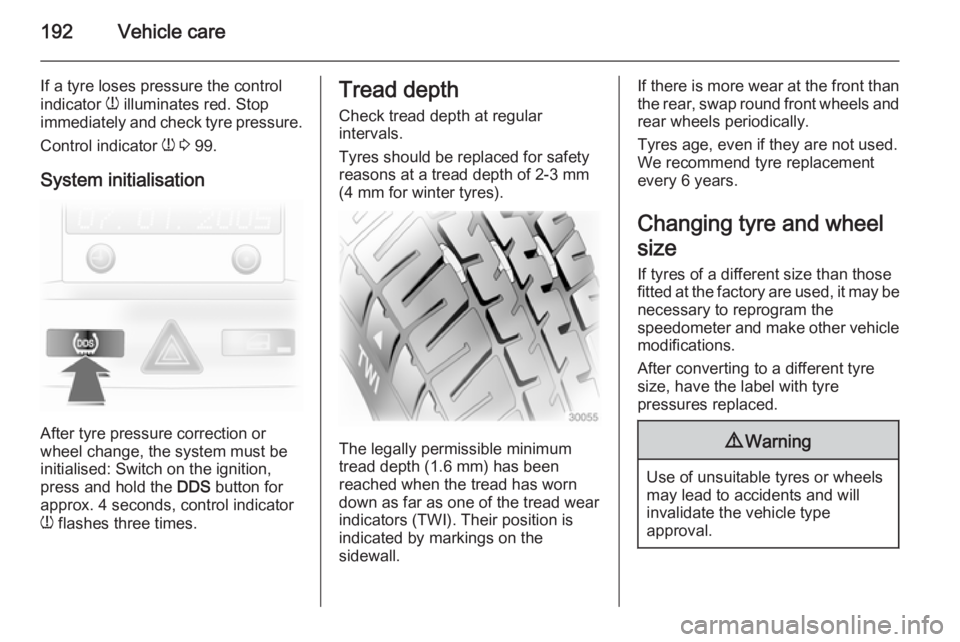
192Vehicle care
If a tyre loses pressure the control
indicator w illuminates red. Stop
immediately and check tyre pressure.
Control indicator w 3 99.
System initialisation
After tyre pressure correction or
wheel change, the system must be
initialised: Switch on the ignition,
press and hold the DDS button for
approx. 4 seconds, control indicator
w flashes three times.
Tread depth
Check tread depth at regular
intervals.
Tyres should be replaced for safety
reasons at a tread depth of 2-3 mm
(4 mm for winter tyres).
The legally permissible minimum
tread depth (1.6 mm) has been
reached when the tread has worn
down as far as one of the tread wear
indicators (TWI). Their position is
indicated by markings on the
sidewall.
If there is more wear at the front than
the rear, swap round front wheels and rear wheels periodically.
Tyres age, even if they are not used.
We recommend tyre replacement
every 6 years.
Changing tyre and wheel
size If tyres of a different size than those
fitted at the factory are used, it may be necessary to reprogram the
speedometer and make other vehicle
modifications.
After converting to a different tyre
size, have the label with tyre
pressures replaced.9 Warning
Use of unsuitable tyres or wheels
may lead to accidents and will
invalidate the vehicle type
approval.
Page 200 of 245
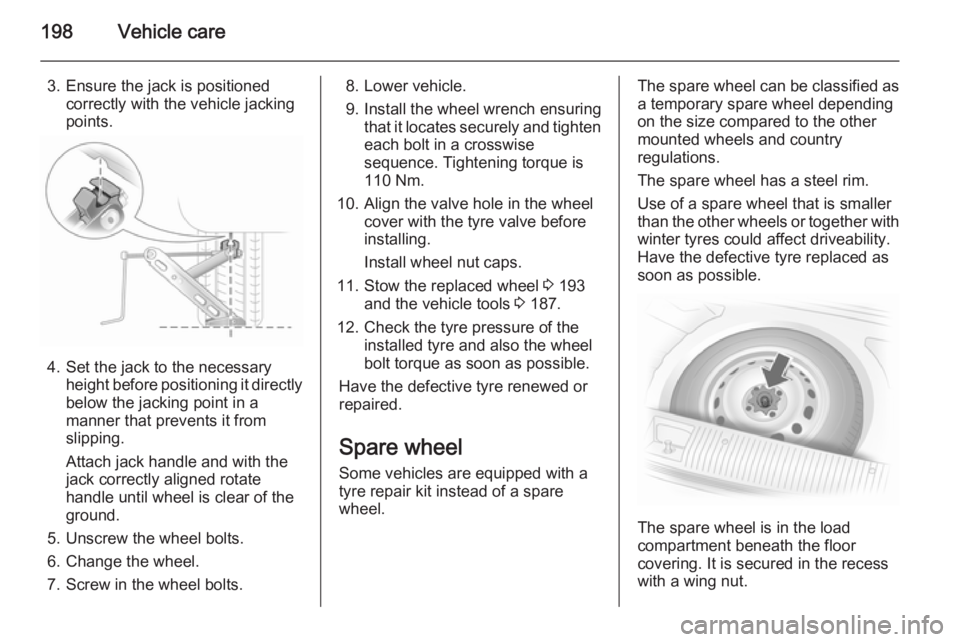
198Vehicle care
3. Ensure the jack is positionedcorrectly with the vehicle jacking
points.
4. Set the jack to the necessary height before positioning it directly
below the jacking point in a
manner that prevents it from
slipping.
Attach jack handle and with the
jack correctly aligned rotate
handle until wheel is clear of the
ground.
5. Unscrew the wheel bolts.
6. Change the wheel.
7. Screw in the wheel bolts.
8. Lower vehicle.
9. Install the wheel wrench ensuring that it locates securely and tighten
each bolt in a crosswise
sequence. Tightening torque is
110 Nm.
10. Align the valve hole in the wheel cover with the tyre valve before
installing.
Install wheel nut caps.
11. Stow the replaced wheel 3 193
and the vehicle tools 3 187.
12. Check the tyre pressure of the installed tyre and also the wheelbolt torque as soon as possible.
Have the defective tyre renewed or repaired.
Spare wheel
Some vehicles are equipped with a
tyre repair kit instead of a spare
wheel.The spare wheel can be classified as
a temporary spare wheel depending
on the size compared to the other
mounted wheels and country
regulations.
The spare wheel has a steel rim.
Use of a spare wheel that is smaller
than the other wheels or together with winter tyres could affect driveability.
Have the defective tyre replaced as
soon as possible.
The spare wheel is in the load
compartment beneath the floor
covering. It is secured in the recess
with a wing nut.
Page 207 of 245
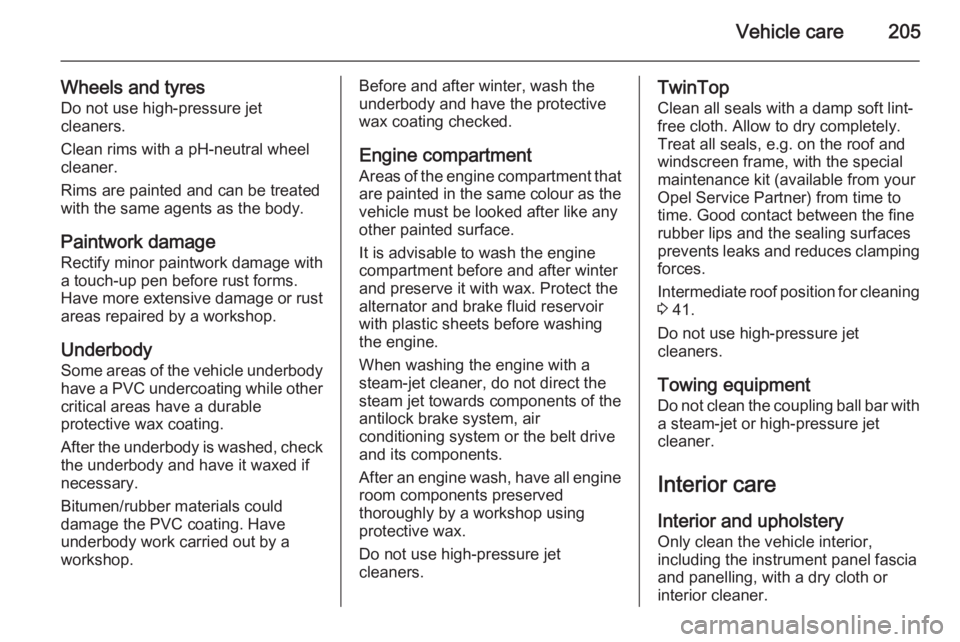
Vehicle care205
Wheels and tyresDo not use high-pressure jet
cleaners.
Clean rims with a pH-neutral wheel
cleaner.
Rims are painted and can be treated
with the same agents as the body.
Paintwork damageRectify minor paintwork damage witha touch-up pen before rust forms.
Have more extensive damage or rust
areas repaired by a workshop.
Underbody Some areas of the vehicle underbody
have a PVC undercoating while other critical areas have a durable
protective wax coating.
After the underbody is washed, check
the underbody and have it waxed if
necessary.
Bitumen/rubber materials could
damage the PVC coating. Have
underbody work carried out by a
workshop.Before and after winter, wash the
underbody and have the protective
wax coating checked.
Engine compartment
Areas of the engine compartment that
are painted in the same colour as the vehicle must be looked after like any
other painted surface.
It is advisable to wash the engine
compartment before and after winter
and preserve it with wax. Protect the
alternator and brake fluid reservoir
with plastic sheets before washing
the engine.
When washing the engine with a
steam-jet cleaner, do not direct the
steam jet towards components of the
antilock brake system, air
conditioning system or the belt drive
and its components.
After an engine wash, have all engine
room components preserved
thoroughly by a workshop using
protective wax.
Do not use high-pressure jet
cleaners.TwinTop
Clean all seals with a damp soft lint- free cloth. Allow to dry completely. Treat all seals, e.g. on the roof and
windscreen frame, with the special
maintenance kit (available from your
Opel Service Partner) from time to
time. Good contact between the fine
rubber lips and the sealing surfaces
prevents leaks and reduces clamping
forces.
Intermediate roof position for cleaning
3 41.
Do not use high-pressure jet
cleaners.
Towing equipment
Do not clean the coupling ball bar with
a steam-jet or high-pressure jet
cleaner.
Interior care Interior and upholsteryOnly clean the vehicle interior,
including the instrument panel fascia
and panelling, with a dry cloth or
interior cleaner.
Page 244 of 245
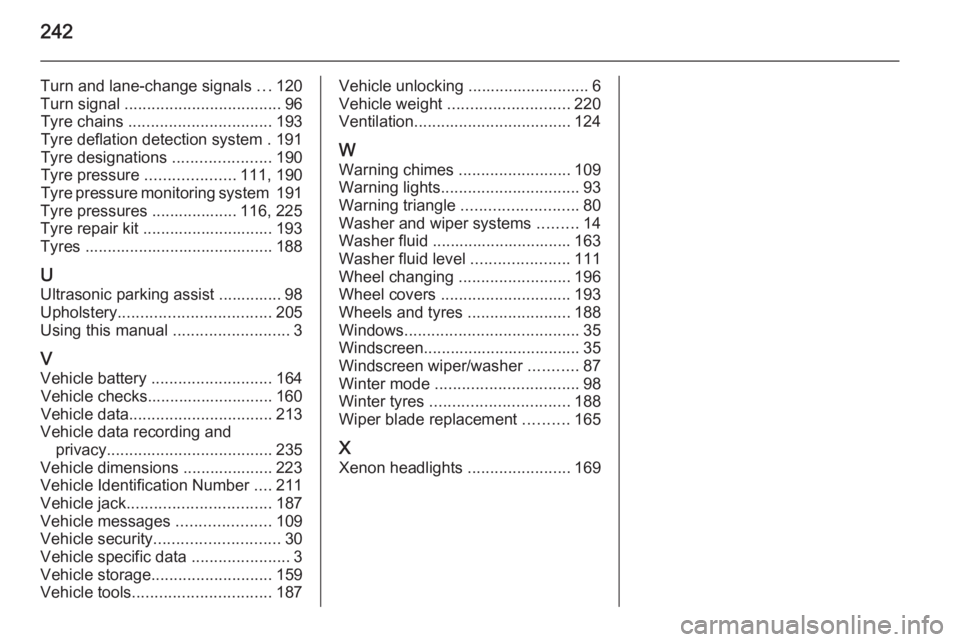
242
Turn and lane-change signals ...120
Turn signal ................................... 96
Tyre chains ................................ 193
Tyre deflation detection system . 191
Tyre designations ......................190
Tyre pressure ....................111, 190
Tyre pressure monitoring system 191
Tyre pressures ................... 116, 225
Tyre repair kit ............................. 193
Tyres .......................................... 188
U Ultrasonic parking assist .............. 98
Upholstery .................................. 205
Using this manual ..........................3
V Vehicle battery ........................... 164
Vehicle checks............................ 160
Vehicle data ................................ 213
Vehicle data recording and privacy ..................................... 235
Vehicle dimensions .................... 223
Vehicle Identification Number ....211
Vehicle jack ................................ 187
Vehicle messages .....................109
Vehicle security ............................ 30
Vehicle specific data ......................3
Vehicle storage ........................... 159
Vehicle tools ............................... 187Vehicle unlocking ........................... 6
Vehicle weight ........................... 220
Ventilation ................................... 124
W
Warning chimes .........................109
Warning lights ............................... 93
Warning triangle .......................... 80
Washer and wiper systems .........14
Washer fluid ............................... 163
Washer fluid level ......................111
Wheel changing .........................196
Wheel covers ............................. 193
Wheels and tyres .......................188
Windows ....................................... 35
Windscreen................................... 35
Windscreen wiper/washer ...........87
Winter mode ................................ 98
Winter tyres ............................... 188
Wiper blade replacement ..........165
X Xenon headlights .......................169